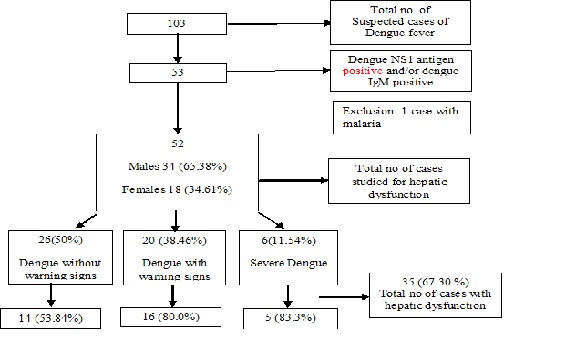Prevalence of hepatic dysfunction in children with dengue fever
Abstract
Background:Dengue is one disease entity with different clinical presentations and often with unpredictable clinical evolution and outcome. The degree of liver dysfunction in children with dengue infection varies from mild injury with elevation of transaminases to severe injury with jaundice and liver cell failure. This study was undertaken to find the prevalence of hepatic dysfunction in children admitted with Dengue fever.
Methods:All children with serologically (dengue NS1 antigen detection and/or dengue IgM Mac ELISA) confirmed dengue fever aged between 2 months and 12 years were included in the study. Children with other etiologies of hepatitis were excluded. Liver function tests including bilirubin, transaminases and prothrombin time (PT) were done. Prevalence and severity of hepatic dysfunction were statistically analysed and compared between different categories of dengue fever severity.
Results:Hepatic dysfunction was present in 35 (67.30%) of the 52 children included in the study.About 85.71% of the children with dengue fever in the age group of 2 months to 1 year had hepatic dysfunction. In children with severe dengue, 83.3% had hepatic dysfunction.Raised liver enzymes in 32(61.53%), hepatomegaly in 21(40.48%), INR≥1.5 in 8(15.38%) and jaundice in 1(1.92%) children were the manifestations. None of the patients had acute hepatic failure or hepatic encephalopathy.Association of hepatomegaly with increasing disease severity was statistically significant (p = 0.0262). Hepatic dysfunction was present in 83.33% and 87.5% of children with abdominal pain and clinical fluid accumulation respectively. Of the 32 patients (61.53%) with elevated transaminases, 18 (51.42%) had elevated levels of AST alone, 40% had elevation of AST and ALT both.
Conclusions: The prevalence of hepatic dysfunction among children with dengue fever is 67.30%, more commonly observed in severe forms of dengue. Spectrum of hepatic involvement ranges from raised liver enzymes without jaundice to clinically evident jaundice. Hepatic dysfunction is commonly observed in children with abdominal pain and clinical fluid accumulation.
Downloads
References
2. World Health Organization. Dengue: Guidelines for Diagnosis, Treatment, Prevention and Control: New Edition. Geneva: World Health Organization. 2009.
3. Alam, A., Sadat, S., Swapan, Z., Ahmed, A., Karim, M., Paul, H., & Zaman, S. (1). Clinical Profile of Dengue Fever in Children. Bangladesh Journal of Child Health, 33(2), 55-58. doi:10.3329/bjch.v33i2.5678.
4. Selvan T, Saravanan P, Nagaraj MV, Tudu MN. Study of hepatic dysfunction ofdengue fever in children. Int J ContempPediatr.2017;4(3): 901- 4. doi:10.18203/2349-3291.ijcp20171695.
5. Bandyopadhyay D, Chattaraj S, Hajra A, et al. A Study on Spectrum of Hepatobiliary Dysfunctions and Pattern of Liver Involvement in Dengue Infection. J Clin Diagn Res. 2016 May;10(5):OC21-6. doi: 10.7860/JCDR/2016/16946.7784. Epub 2016 May 1.[pubmed]
6. Martínez Vega R, Phumratanaprapin W, Phonrat B, et al. Differences in Liver Impairment Between Adults and Children with Dengue Infection. Am J Trop Med Hyg. 2016 May 4;94(5):1073-9. doi: 10.4269/ajtmh.15-0507. Epub 2016 Mar 14.[pubmed]
7. Wahid SF, Sanusi S, Zawawi MM, et al. A comparison of the pattern of liver involvement in dengue hemorrhagic fever with classic dengue fever. Southeast Asian J Trop Med Public Health. 2000 Jun;31(2):259-63.[pubmed]
8. Wiwanitkit V. Liver dysfunction in Dengue infection: an analysis of the previously published Thai cases. J Ayub Med Coll Abbottabad. 2007 Jan-Mar;19(1):10-2.[pubmed]
9. Kumar R, Tripathi P, Tripathi S, et al. Prevalence of dengue infection in north Indian children with acute hepatic failure. Ann Hepatol. 2008 Jan-Mar;7(1):59-62.[pubmed]
10. Engorn B, FlerlageJ,Johns Hopkins Hospital. Children's Medical and Surgical Center. The Harriet Lane handbook: a manual for pediatric house officers. 20th ed. Philadelphia, PA: Mosby/Elsevier; 2014.
11. Parthasarathy A, Menon P. IAP Textbook of pediatrics. 4th ed. New Delhi: JaypeeBrothers,Medical Publishers Pvt. Limited; 2008.
12. Narvaez F, Gutierrez G, Pérez MA, et al. Evaluation of the traditional and revised WHO classifications of Dengue disease severity. PLoSNegl Trop Dis. 2011 Nov;5(11):e1397. doi: 10.1371/journal.pntd.0001397. Epub 2011 Nov 8.[pubmed]
13. Jagadishkumar K, Jain P, Manjunath VG, et al. Hepatic involvement in dengue Fever in children. Iran J Pediatr. 2012 Jun;22(2):231-6.[pubmed]
14. Mohan B, Patwari AK, Anand VK. et al. Hepatic dysfunction in childhood dengue infection. J Trop Pediatr. 2000 Feb;46(1):40-3. doi: 10.1093/tropej/46.1.40.[pubmed]
15. Tambolkar SA, Mishra A, Joshi H, Agarkhedkar S. Liver Functions as a marker of severity of disease in children with Dengue fever. WebmedCentral PAEDIATRICS 2015;6(8):WMC004962
16. Singh S, Meena JK, Verma CR, Bhaskar V. A hospital-based study of hepatic dysfunction in children with dengue fever. Asian Pacific J Trop Dis 2015;5(12):964-7.

Copyright (c) 2019 Author (s). Published by Siddharth Health Research and Social Welfare Society

This work is licensed under a Creative Commons Attribution 4.0 International License.


 OAI - Open Archives Initiative
OAI - Open Archives Initiative


